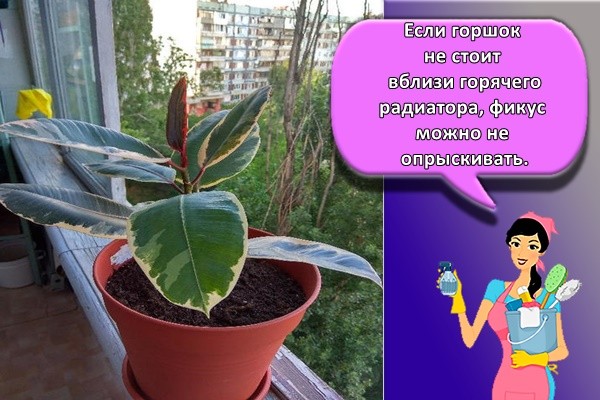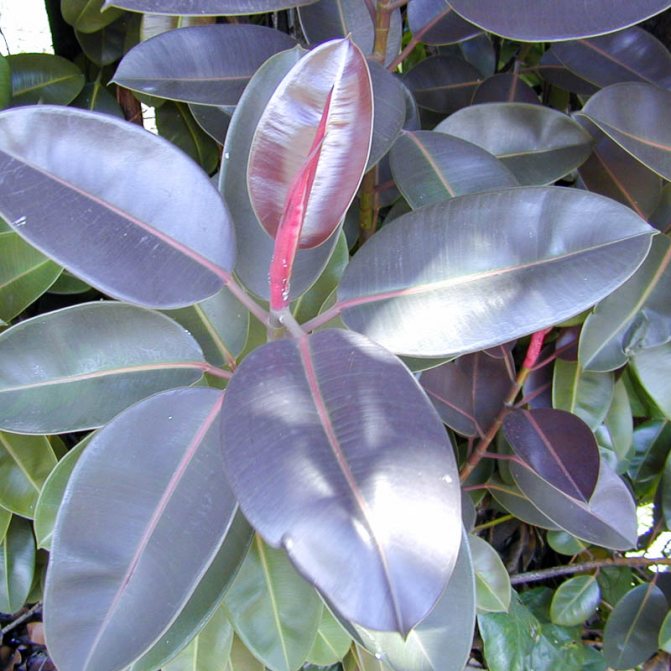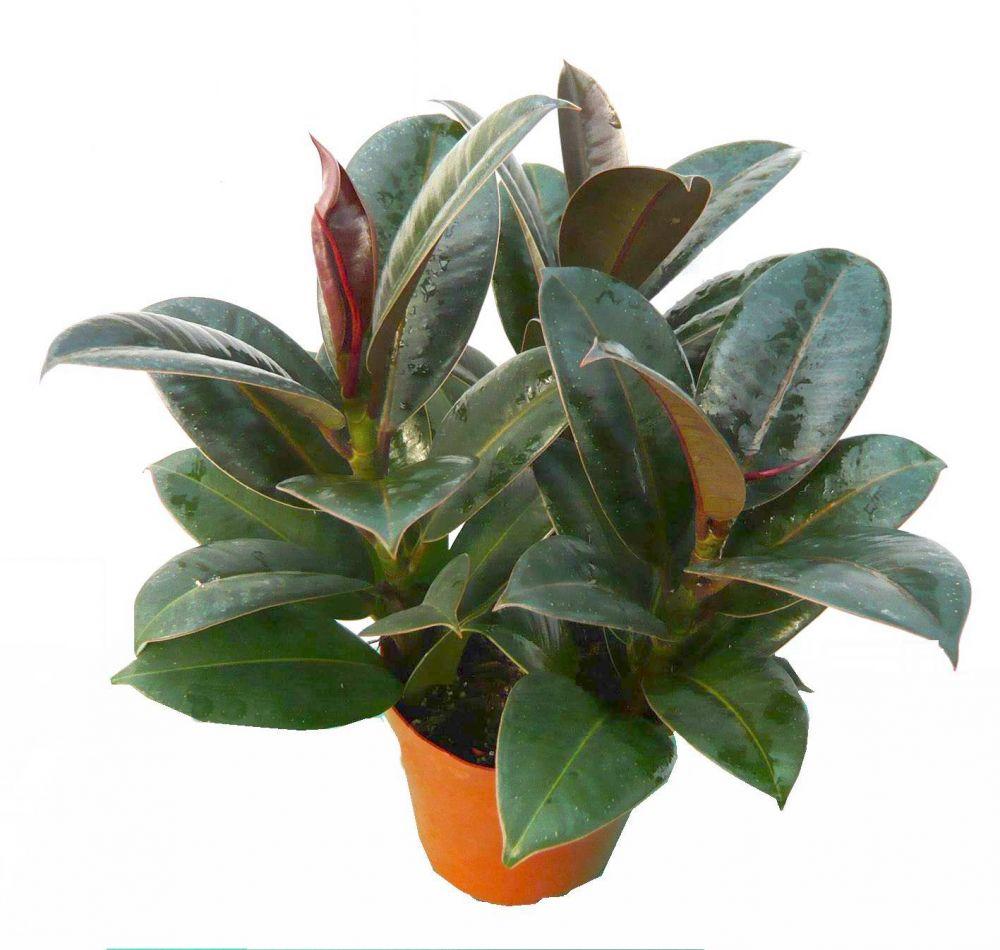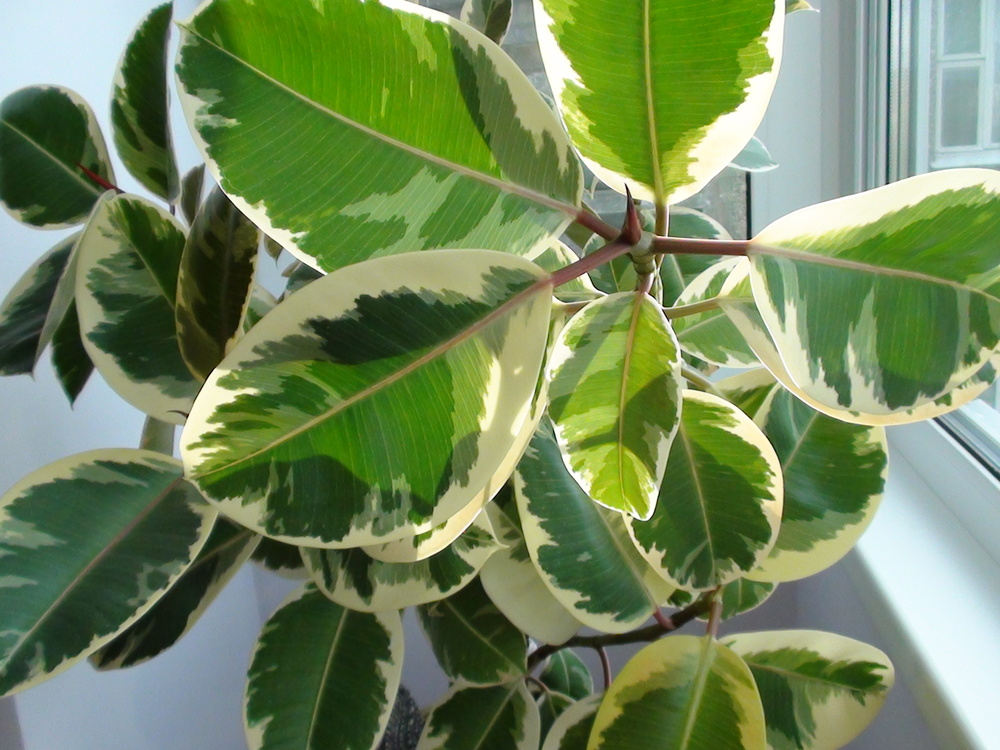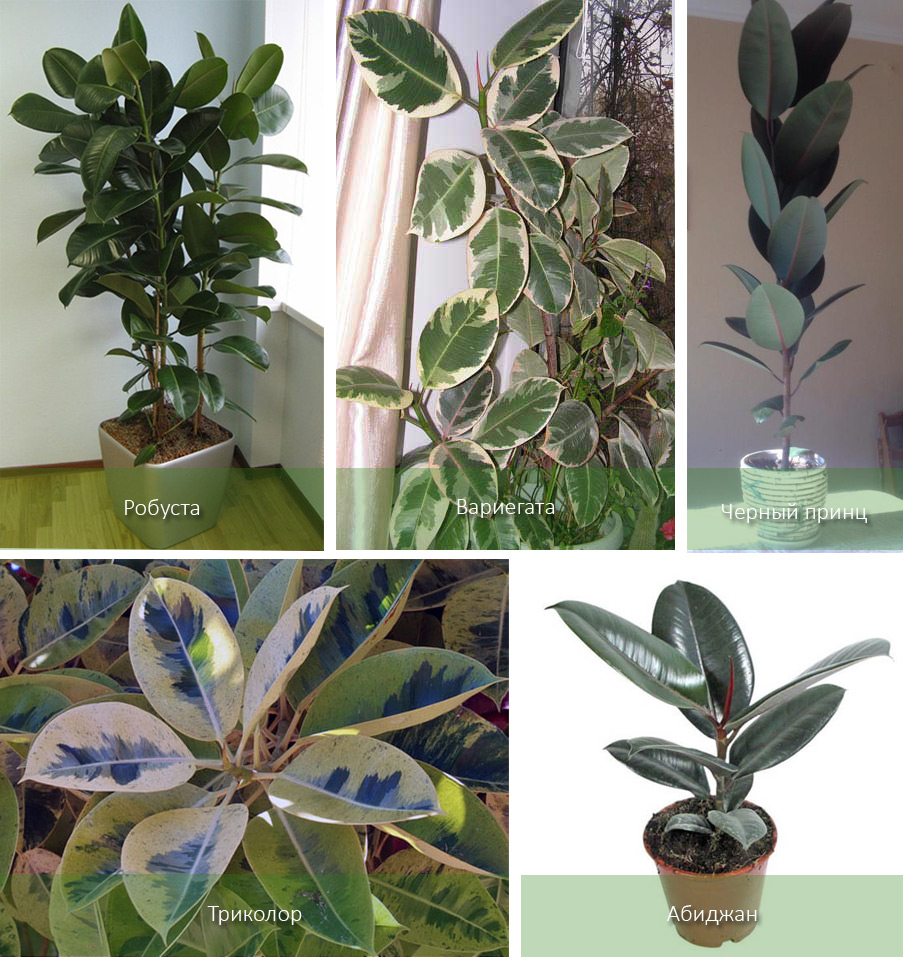Ficus care at home
Although ficus belongs to unpretentious crops, its exotic nature requires adherence to certain rules.
Temperature features, lighting, humidity
One of the important features of the culture is the dislike for abrupt changes in location. Therefore, before purchasing a plant, the florist must take care of the place where it will grow. Preference should be given to windows of the eastern and western directions, from which it is possible to provide the light regime necessary for the ficus - a large amount of bright and diffused light. Varieties with solid leaves can be placed in partial shade.

Attention! In winter, with a short daylight hours, the flower needs additional lighting with fluorescent lamps.
- in summer it is 25 - 30 ° C;
- in the winter season - 16 - 20 ° C.
For almost all members of the genus, with the exception of dwarf ficus, the maximum allowable value, below which the temperature should not fall, is 12 ° C.
So that no traces of water remain on the glossy sheet plates, they should be periodically wiped with a damp sponge, which will also free the flower's breath from dust.
Soil requirements

In order for the plant to become an interior decoration and retain its decorative qualities for many years, a representative of the tropics should be grown in a fertile soil mixture purchased in a store or prepared independently. When preparing the substrate with your own hand, leaf, sod land, peat and sand are taken in equal parts. If there is no extra time for such manipulations, then you can purchase a special substrate for ficuses.
Watering and feeding
When watering, it is necessary to control the moisture content of the earthen coma
This is important in order to prevent the soil from drying out, leading to the release of leaves, and its waterlogging, which provokes the development of gray rot. If the substrate has dried out to a depth of 2 phalanges of the finger, then it should be moistened with another portion of warm, settled water

In order for the plant to be lush and with beautiful leaf plates, it is recommended to systematically feed the flower with liquid mineral fertilizers at intervals of 10 days. For monochromatic forms, complexes with a high nitrogen content are used, which stimulate the growth of green mass. However, if the grower is the owner of a variegated variety, then the introduction of nitrogen should be limited so as not to lose the fancy pattern.
Cropping and shaping the crown
Ficus needs pruning for two reasons: rejuvenation and shaping the crown. Formative pruning allows you to get a bush, standard plant, bonsai and even a sculpture. But before starting a haircut, it is worth considering the specifics of the species: for example, in the case of rubbery ficus, pruning the central shoot will not lead to branching. Sanitary pruning is carried out every spring when diseased, damaged and old shoots are removed from the plant.
General rules for pruning, which are recommended to be observed regardless of the type and variety:
- Before trimming, you should present the appearance of the plant after completion of the procedure.
- Carry out a haircut only with a sharp and disinfected tool.
- The cut should be made at an angle.
Plant transplant
Young specimens are transplanted annually into pots with a diameter 2 - 3 cm larger than the previous one. For adult, tall plants, the top layer of the substrate is renewed every spring. And the transplantation of adult specimens is carried out only after the roots appear in the drainage holes, which indicates that the earthen coma is completely entwined with the root system.
The procedure is carried out according to the following scheme:
- A new pot is selected, at the bottom of which a layer of drainage material is placed.
- A flower is rolled into a new container along with an old earthy clod.
- The remaining free space is filled with fresh, nutritious substrate.
Caring for ficus in winter involves reducing the volume and frequency of water procedures, as well as top dressing. But if the ficus continues to be kept under summer conditions (long daylight hours, high temperature), then moistening is carried out in the same mode, and feeding is carried out every 1.5 months with a half dosage.
Diseases and pests
Ficus is susceptible to attacks of scale insects, mealybugs, spider mites. If they are found, the plant is bathed in the shower and treated with insecticides. The rest of the problems are associated with inaccuracies in care.
- Leaves curl and wither. The temperature is too low. The plant is rearranged in a warm place, protected from drafts.
- The tips of the leaves dry out. Low humidity in the apartment. It is recommended to spray the plant.
- Falling leaves. There are many reasons - excessive, poor watering, lack of light, cold, drafts. Falling of the lower leaves is normal in mature plants.
- Shredding of leaves and slow growth. Signs of a lack of trace elements in the soil. It is recommended to transplant the plant into fresh soil or to increase the frequency of fertilization.
- White bloom on the leaves. The manifestation of powdery mildew. Appears with high humidity and poor ventilation of the room. The damaged leaves are removed, the flower is treated with fungicides.
Large leaves of ficus in the daytime actively absorb carbon dioxide and emit oxygen. The plant promotes natural air purification in the apartment.
Ficus elastica, which is better known as rubbery ficus, is one of the most common potting crops. This plant filters the air, cleans it from harmful substances and saturates it with oxygen. In addition, elastica ficus is considered a symbol of the family hearth.
Does the rubber plant require special care, how to properly organize the place, and what microclimate is needed for this plant? More about everything further.
Solving the main problems in growing
A slowdown in growth and a deterioration in the appearance of the plant require adjusting the care. Let's take a look at common problems.
Yellowing of leaves
The foliage turns yellow when the air is too dry, hot (in winter from radiators), direct hot sun, lack of nitrogen fertilizers. It is required to choose a convenient place for the plant, to feed it.
Shedding foliage
The bush sheds foliage for a number of reasons:
- rotting roots - reduce watering, transplant;
- insufficient nutrition - adjust feeding, increase the pot, replace the soil.
Poor soil drainage is a common cause of foliage shedding. Additional holes are made in the containers, a layer of expanded clay is laid out.
Growth and development problems
Vegetation freezes for a number of reasons - root rot due to excess moisture (normalize watering), lack of nutrients (top dressing), too small a pot (transplant), little light (rearrange closer to the window).
Reproduction of ficus robusta
Like most representatives of the species, the Robusta ficus can be propagated in several ways: by cuttings, layering, seeds, leaves. In all cases, it is good to use phytohormones to accelerate root formation.
Cuttings
This method is the most convenient and widespread. The best time for him is the last week of winter - the beginning of spring. As a planting material from which ficus propagates, you can use any cuttings: green, half or completely lignified. Moreover, the apical specimens are preferable to those taken from the middle of the shoot.
The procedure is as follows:
- slices of stems with 2 - 3 leaves are cut from the tops of the shoots;
- milky juice is washed off from the cut points so that it does not clog the conducting vessels;
- within an hour, the sections are air-dried;
- prepared planting material is planted obliquely in containers filled with light earth with sand or clean sand.
In large-leaved ficuses, and this is exactly what Robusta is, before planting, the leaves are twisted into a tube, they are tied up, and the seedling is tied to a peg to give it stability, which is stuck into the ground through the center of the tube.
The cuttings take root within 20-60 days. Rooting will take place faster in the presence of soil heating, an air temperature in the room of 24-28 ° C and a humidity of about 80%.

Caring for cuttings consists in keeping the soil in a constant state of moisture and spraying on the leaves. To maintain the humidity at the required level, the cutting can be covered with a jar or plastic bag, not forgetting to open it from time to time for ventilation.
Layers
The second most popular breeding method at home is by layering. This is a great opportunity to bring back to life a plant that has lost the lower part of the crown. From adult ficuses for layering, you can take fully formed shoots and even whole branches, which will be much larger in size than any cuttings.
The procedure is as follows:
- an oblique incision is made on the branch you like for the appearance of roots;
- so that the incision does not close, a match is inserted into it, they wrap this place with wet moss, and on top of it with black plastic wrap;
- until roots are formed, the moss is kept moist by adding water under the film with a syringe.
After 2-3 months, when the roots are formed, the branch along with the roots is cut off and planted for rooting in a light nutritious substrate.
Leaves
Only strong and healthy specimens are chosen as planting material for leaf propagation at home. They are cut off along with a piece of the shoot. The cut is made obliquely, impregnated with some kind of root formation stimulant.
For the appearance of roots, the cut off shoot is placed in a bowl with warm, settled water or wet cotton wool. The sheet itself should not touch the water. When roots appear on the cut piece of the stem, a cup is planted for rooting. The process of germination of roots can be skipped in water, immediately after treatment with root-forming stimulants, plant them in a light nutrient substrate, cover with a glass cover or plastic wrap and leave for rooting.
Seeds
This method is usually used in cases where it is difficult or impossible to get material for grafting or cuttings. In order not to be disappointed with the result, it is advisable to buy seeds from well-established, trusted sellers.
Before planting, it is advisable to soak the seeds in a biostimulator for several hours. Then they are laid out on the surface of the soil moistened with a spray bottle. If the planting material is of high quality, seedlings appear in a week.
Diseases and pests of ficuses
In unfavorable conditions, a ficus can be exposed to some diseases, but insect pests are much more terrible for a plant.
Mealybug. This pest can be easily spotted as it looks like a patch of brown cotton wool. In this case, the plant is treated with folk remedies.
Aphid. This insect is dangerous not only for ficus, but also for nearby plants. Treatment consists in spraying foliage with soapy water. When a flower is infected with aphids, it is quarantined until complete recovery.


Thrips. This insect lives on the inside of foliage. The parasite is dangerous because it sucks out all the juice from the plant and leads to its death. Treatment consists in multiple treatment with Pyrethrum solution.
Nematodes. These parasites infect the root system, laying their larvae on it. If no help is provided, the excretion of worms will penetrate the trunk of the ficus and destroy it.
Shield. When attacked by this insect, brown spots form on the outside of the leaf plate.The fight consists in spraying the plant with soapy water and processing the leaf with Aktelik. If the plant is not given proper care, then fungal diseases can join:
Fungus on the leaves. The fungus manifests itself as black spots on the foliage, which lead to the drying out and death of the leaf plate.
Gray rot. The disease appears in a room that is too hot and when overflowing ficus. In the process of the disease, mold appears on the stem and leaves, which, when shaken, easily flies off the plant. Treatment consists in removing the affected areas. Prevention: moderate watering and frequent ventilation of the room.
A sooty mushroom. A gray coating appears on the leaves. To get rid of a fungal disease, you need to regularly wipe the foliage with soapy water. In case of mass infection, it is better to remove the affected leaves from the plant in order to avoid the spread of the disease.
Root rot. When affected by a fungus, the ficus becomes gray and dies. No cure has yet been found for this disease.

Improper care leads to fungal diseases

How to get rid of midges in indoor flowers using simple methods. In a special publication of our portal, we will tell you in detail how to get rid of pests in indoor flowers. You will learn the reasons for their appearance, the types of midges and their signs and measures to prevent the appearance of midges.
Watering rubbery ficus
Maintaining moderate soil moisture is one of the most important rules for caring for ficus. An excess of moisture in the pot of rubber ficus interferes with the correct formation of the crown and leads to a slow withering of the rhizome - the heart of the plant. The appearance of red spots on the leaves is a sure sign of moisture saturation.
In the summer, water the ficus 1-2 times a week, in winter, 1 time is enough. In order to check whether the plant needs watering, dip your finger into the pot to a depth of 2-3 cm, if the soil is dry, moisten it. Leaves also need to be sprayed and wiped, but rather to get rid of dust than to moisturize. This should be noted for those who do not know how to make the ficus branch, because this simple procedure helps to increase the number of branches and leaves.
Diseases and pests
Ficus Robusta is resistant to diseases and pests. Of the latter, it is most often attacked by spider mites. A good result when getting rid of it is given by spraying and washing the leaf plates, as well as putting a plastic cap on the crown for 3-4 days. Most diseases are the result of improper care: sunburn or lack of lighting, excessively high air temperatures or drafts, waterlogging or lack of moisture, frequent change of location. The main problems that you can face:
- Ficus has dropped the leaves, they dry and fall off. Sometimes adult specimens shed green mass in order to renew the crown with new shoots. But more often this phenomenon is caused by dry air, insufficient watering, depletion of the soil or exposure to pests.
- Leaves are curled up. Most often, the reason is improper watering: the plant either receives less moisture, or receives it in excess. How can I save him? Optimize watering.
- Leaves turn yellow. Iron deficiency is a major contributor to yellowing. To eliminate it, the soil must be fertilized with iron chelate or ferrovite.
- Leaves turn black. Perhaps the black spots and dots are sunburn. The danger is that pests can easily penetrate into such places. It is best to remove the affected leaves, treat the roots and crown with a fungicide.
- The trunk rots. Once again, remember how often you need to water the ficus. This is most likely the problem.
Ficus rubbery - description
Such a flower probably grew in all government agencies, hospitals, theaters, in the homes of amateur florists.With an erect stem-stem and large oval leaves, this flower has taken root well in our climate, even though it comes from one of the largest islands on the planet - Sumatra. There, in the humid tropics, rubber ficus is the most common type of vegetation. What was the journey of this equatorial inhabitant to our frosty lands, history has not preserved, but the fact that the climate change did not harm him is an obvious fact. The unpretentiousness of this plant makes it quite popular among lovers of home exoticism.
In Latin, the name of this flower is "Ficus elastica" that is elastic ficus. The ficus owes this name to the fact that its juice contains elastic natural rubber. In its native expanses - the forests of tropical Sumatra, ficus sometimes reaches a height of up to 40 meters. The people of India use the endurance and flexibility of ficus to build bridges, and they literally grow ficus suspension bridges.
Ficus rubber has large, strong leaves, which are attached to the trunk with strong petioles. The color of the leaves varies from dark green to light, their glossy surface is shiny and leathery. Some varieties of ficus have streaks or blotches on leaves of a different color.
The milky juice of the ficus flowing along the stem and leaves not only supplies humanity with rubber, but also causes allergies in humans, which manifests itself in reddening of the skin.
However, domesticated ficus is different from its natural relative. Florists have bred such species of this plant as the Robusta variety, the Decor variety, and the Tineke variety with variegated leaves.
Types of elastica for home cultivation
The plant, in its natural environment, reaches a height of 40 m, when grown indoors it grows up to 10 m, but this is a rare case, as a rule, the height is no more than 1 m.
The leaves of the tree are a glossy oval with a pointed end, rather large (up to 30 cm long). At a young age they are pinkish-brown, at an old age they are dark green.
Fruits are yellow-green, oval, with a diameter of 1 cm. At home cultivation, the flowering of ficus is very rare.
Regardless of which variety of ficus was transplanted, care for it must be correct, otherwise the plant will die.
Additional Information! After transplanting, there may be a suspension in the growth of the aerial part and partial loss of leaves.
Principles of caring for ficus after the procedure:
- Temporarily stop feeding, as the new soil is quite fertile.
- Reduce watering in the first month to 1 time per week, but at the same time carry out daily spraying of the crown.
- Place the flowerpot in a slightly shaded place to allow the flower to adapt to new conditions.
To reduce stress on the plant, it is enough to plant a small seedling along with an earthen clod in a permanent pot. The transport container is usually filled with peat, which will form the basis of a fertile substrate.

Ficus planting option

Young and healthy ficus
Ficus rubber has such a name due to the presence of thick juice in the stems and leaves. This juice is used to make rubber.
The beauty and strength of the flower is manifested in its sinewy and large leaves. At the beginning of the 20th century, when the fashion was for a pretentious and lush lifestyle, the ficus was not so popular. This is because the plant did not have distinctive external parameters, therefore it was quickly forgotten by the flower growers of that time.
Important! In its homeland, ficus is considered a noble and sacred plant. Local Buddhists protect and honor the flower
They believe that ficus has magical and healing properties.
At the beginning of its growth, it resembles a single-stemmed tree with an undeveloped branching system. Prefers to be in a place filled with sunlight.
At the ends of the branches, aerial roots are formed, which in the process of development grow into trunks. Thanks to this method of growth, the ficus got the name "snake tree".

Such a culture is not picky, does not require a significant investment of time and money for care.
Interesting to know! Drops of milky sap may appear on the leaves of the rubber tree. This substance has significant irritant properties. In contact with the skin or mucous membranes of a person, it can cause allergies, itching and rashes. The affected area should be rinsed immediately with plenty of clean water.
Before buying, you should carefully study the flower: the soil should be clean, without mold, young roots, fresh leaves. You can plant and grow a flower at home.
Prepare a new pot that is at least 3 cm larger than the old one. You will also need soil for ficus, soot or coal, expanded clay.
The place should be sunny, warm, draft-free. The east or west side is perfect.

The optimal place for the growth of any type of ficus is the sunny side
A transplant is possible after 2-3 weeks of adaptation in a new place. They do it this way:
- A little coal is added to the already prepared soil mixture.
- Cleanses the root system from excess. The damaged areas are sprinkled with coal soot.
- Transfer the plant to a new pot, cover with earth until the beginning of the root collar.
- Expanded clay is placed at the bottom of the pot to strengthen the root system.
The new plant is watered after 4-6 days.

After transplanting, the leaves may fall off - this is normal. The ficus will not take root quickly, it will take time.

Ficus root system
Rubber ficus, how to make it branch. How to make an old ficus grow from below with new branches?
This question is not the first time I have been asked this question in the spring. I had a similar experience, so I will share how I stimulated my old ficuses for this feat. During the winter, many ficuses lose their foliage due to the difficulties of wintering in an apartment. Dry air due to the heating system, little light, and at the same time cold windowsills are the main scourge for indoor plants that winter in the cold climate of our country. But besides this there is another reason - below the trunks become bare over time due to natural reasons ... The tree grows, the crown develops at the top, and at the bottom the trunk becomes bare. This happens with all trees in the wild. So my ficus, having reached its maximum growth, as much as it was allowed by the conditions of the room and the size of the pot, exposed the trunks in the lower part. And the top of his head rested against the ceiling. He felt cramped on the windowsill, but he couldn't put it on the floor either: it's too dark, because I live in the Urals - we have dark winters in recent years.
Reproduction of ficus
At home, ficuses reproduce by vegetative methods.
Apical cuttings

The procedure is carried out in the spring-summer period:
- From the apical part of the shoots, planting material 10-15 cm long is cut at an angle.
- The leaf plate in the internode 1 cm above the cut is removed or shortened by ⅓.
- The milky juice is washed off under running water, after which the cuttings are dried in the fresh air for several hours, and then treated with a growth stimulant.
- Cuttings are buried in a soil mixture of peat and sand in equal parts to the second internode.
- The plantings are covered with a film, which allows you to create greenhouse conditions with the required level of humidity and temperature values.
- When new young leaf plates are formed, which is evidence of rooting of cuttings, young plants are planted in individual pots.
Air layering
A similar method is used to rejuvenate the ficus, which in the process of growth has lost the lower tiers of leaf plates and began to look not well-groomed.
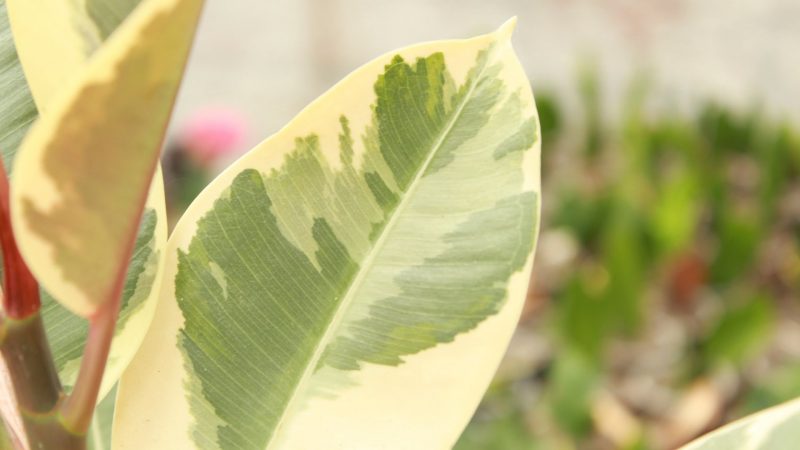
During the procedure:
- On the bare trunk, oblique cuts are made in a circle.
- The injured area is wrapped in wet moss and fixed with tape.
- Sphagnum is systematically moistened.
- After the formation of roots, the cuttings slightly below the damaged area are cut off and planted in a prepared pot with drainage and substrate for an adult plant.
Sheet
This method is not the same as the conventional leaf propagation used for other potted crops. To implement this technique, a stalk with one leaf plate is actually used.

To achieve success, follow this algorithm:
- An oblique cut of the cutting is made along the node itself.
- The planting material is placed in a mixture of sand and peat up to the petiole of the leaf plate.
- The folded sheet is fixed with a thin strip of tape or electrical tape, depending on what is at hand.
- With the help of the film, a mini-greenhouse is created, under which the moisture level of the soil mixture is constantly monitored.
- The rooted cuttings are planted after the appearance of a young leaf.








